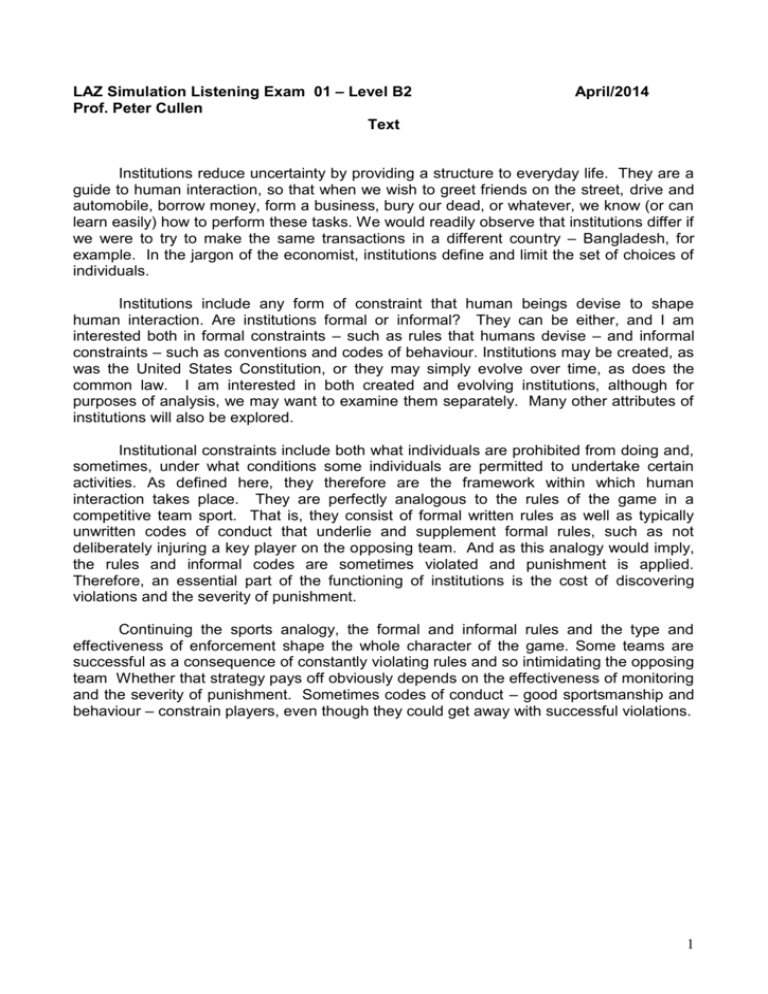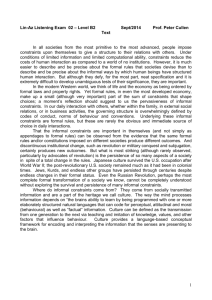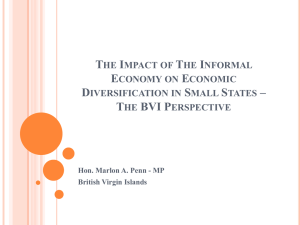LinAZ B2 Simulation Listening Exam 1 04 2014
advertisement

LAZ Simulation Listening Exam 01 – Level B2 Prof. Peter Cullen Text April/2014 Institutions reduce uncertainty by providing a structure to everyday life. They are a guide to human interaction, so that when we wish to greet friends on the street, drive and automobile, borrow money, form a business, bury our dead, or whatever, we know (or can learn easily) how to perform these tasks. We would readily observe that institutions differ if we were to try to make the same transactions in a different country – Bangladesh, for example. In the jargon of the economist, institutions define and limit the set of choices of individuals. Institutions include any form of constraint that human beings devise to shape human interaction. Are institutions formal or informal? They can be either, and I am interested both in formal constraints – such as rules that humans devise – and informal constraints – such as conventions and codes of behaviour. Institutions may be created, as was the United States Constitution, or they may simply evolve over time, as does the common law. I am interested in both created and evolving institutions, although for purposes of analysis, we may want to examine them separately. Many other attributes of institutions will also be explored. Institutional constraints include both what individuals are prohibited from doing and, sometimes, under what conditions some individuals are permitted to undertake certain activities. As defined here, they therefore are the framework within which human interaction takes place. They are perfectly analogous to the rules of the game in a competitive team sport. That is, they consist of formal written rules as well as typically unwritten codes of conduct that underlie and supplement formal rules, such as not deliberately injuring a key player on the opposing team. And as this analogy would imply, the rules and informal codes are sometimes violated and punishment is applied. Therefore, an essential part of the functioning of institutions is the cost of discovering violations and the severity of punishment. Continuing the sports analogy, the formal and informal rules and the type and effectiveness of enforcement shape the whole character of the game. Some teams are successful as a consequence of constantly violating rules and so intimidating the opposing team Whether that strategy pays off obviously depends on the effectiveness of monitoring and the severity of punishment. Sometimes codes of conduct – good sportsmanship and behaviour – constrain players, even though they could get away with successful violations. 1 LAZ Simulation Listening Exam 01 – Level B2 April/2014 Prof. Peter Cullen ___________________________________________ Name, Date, and Registration Number Questions: Answer all 5 of the following questions. SIMPLE AND CORRECT IS BETTER THAN COMPLICATED AND WRONG. USE SHORT PHRASES AND SENTENCES. This exam requires interpretation and analysis. It is designed to test your ability to apply what you hear to possible discussion areas. 1. In which ways are institutions guides to human interaction? 2. What are the differences between a formal and an informal institution? 3. Why does the speaker make an analogy to sports? 4. What is the role of punishment in institutions? 5. How might formal and informal institutions work together to shape behaviour? 2 LAZ Simulation Listening Exam 01 – Level B2 Prof. Peter Cullen April/2014 Answer Sheet 1. In which ways are institutions guides to human interaction? when we wish to greet friends on the street, drive and automobile, borrow money, form a business, bury our dead, or whatever, we know (or can learn easily) how to perform these tasks 2. What are the differences between a formal and an informal institution? formal constraints – such as rules that humans devise – and informal constraints – such as conventions and codes of behaviour 3. Why does the speaker make an analogy to sports? INSTITUTIONS consist of formal written rules as well as typically unwritten codes of conduct that underlie and supplement formal rules, such as not deliberately injuring a key player on the opposing team. 4. What is the role of punishment in institutions? Institutions enforce rules and use punishment to create conformity. 5. How might formal and informal institutions work together to shape behaviour? Whether that strategy pays off obviously depends on the effectiveness of monitoring and the severity of punishment. Sometimes codes of conduct – good sportsmanship and behaviour – constrain players, even though they could get away with successful violations. (so informal institutions complete formal ones). 3








